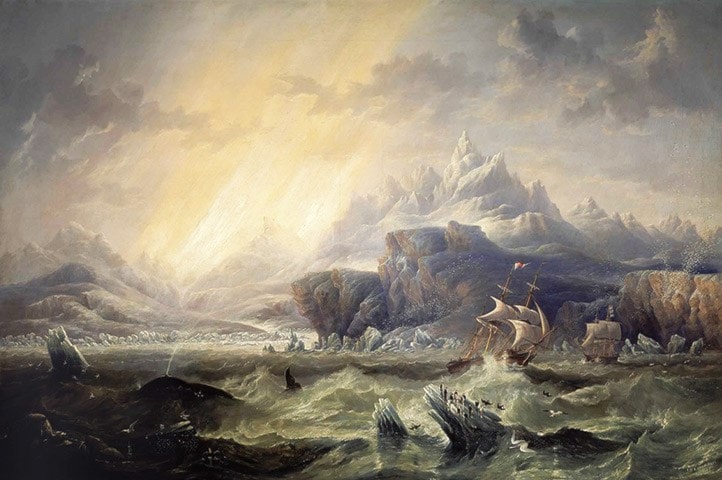This feature was started, more than four years ago, to look at some of the stories and legends, quirks and oddities, of our local region. However, I crave your indulgence this week, as I take you far from the B.C. Interior; take you instead to a land far north to a place where men gambled their reputations—and sometimes their lives—in an attempt to find the fabled Northwest Passage.
No expedition in search of the route is more celebrated, lamented, or studied than the Franklin expedition, which set out from Britain in 1845 with an almost hubristic certainty that this would be the expedition that found the route. The Northwest Passage meant a faster shipping route to the east, and great glory would go to the man who found it.
The expedition was led by Sir John Franklin, who had already made two Arctic expeditions and was a national hero (although, in a perhaps prophetic vision of things to come, his first expedition, in 1819, had ended in disaster, death, and allegations of cannibalism). At age 59, he was really too old to lead such an expedition; but his formidable wife Jane, seeing an opportunity for her husband to cement his reputation forever, used all her considerable influence to ensure that he commanded the expedition.
Two ships—the Erebus and the Terror—were fitted for Arctic exploration, with sheet iron covering the bows, and steam locomotives with specially adapted screw propellers installed for emergency use. Enough provisions to last three years were on board each ship. Franklin commanded the expedition, with Francis Crozier commanding the Terror and James Fitzjames commanding Erebus. The latter ship is commemorated in “The Star-Spangled Banner”: the line “And the rockets’ red glare” refers to the rockets fired by Erebus at Fort McHenry in Baltimore during the War of 1812.
Franklin and 133 others set sail from Britain on May 19, 1845. Five men were discharged as “unsuitable” during one of the expedition’s stops; and the ships were last spotted by Europeans in Baffin Bay in late July 1845, waiting for better conditions to cross to Lancaster Sound.
This is where the Franklin expedition enters the realm of legend, for what happened to it after that involves a few facts and a good deal of educated guesswork. We know that three crew members died during the expedition’s first winter of 1845–46, as they were buried on remote Beechey Island, where the ships stayed, locked in ice. In 1846 the expedition headed west, only to come to a halt at the northwest tip of King William Island later in the year, once more frozen in by the remorseless Arctic ice.
This was by no means an uncommon development in Arctic exploration, and was the reason the expedition carried three years’-worth of supplies. However, the men on Erebus and Terror could have had no idea that the ice was not about to let go its unrelenting grip. A British Admiralty official document that was found at a cairn on King William Island in 1859 has a handwritten message dated 1846 that gives a few notes about the expedition. Far more ominous is another handwritten message around the border of the same document, dated April 25, 1848: “H.M. ships ‘Terror’ and ‘Erebus’ were deserted on the 22d April, 5 leagues N.N.W. of this, having been beset since 12th September 1846. The officers and crews, consisting of 105 souls, under the command of Captain F. R. M. Crozier, landed here. John Franklin died on the 11th June, 1847; and the total loss by deaths in the expedition has been to this date 9 officers and 15 men.”
This note was signed by both Crozier and Fitzjames, and added that they and the remaining crew members would “start to-morrow, 26th [April 1848] for Back’s Fish River [now the Back River, Nunavut]”. No one survived the journey, and until now, researchers have assumed that the remaining men set out on foot for Back’s Fish River and perished along the way. That was the conclusion when the first news of the expedition’s fate reached Britain in 1854, when explorer John Rae confirmed that everyone on board the two ships had died after abandoning their vessels.
The search for the Franklin expedition that began in 1848 has continued to this day, as historians seek to find answers to questions that are buried in time.
In 2014, the Canadian Government and the Arctic Research Foundation announced that they had found the Erebus, beneath 11 metres of water; and earlier this month came news that the same team has found what is almost certainly the Terror. The condition of the ship, and the location where it was found, seem to suggest that rather than head south to Back River, some of the survivors returned to the ship—which might have finally broken free of the ice that engulfed it—and made a last, desperate effort to sail for home. What researchers find on board the ships might reveal new details about the Franklin expedition and cause the rewriting of history, which is seldom as fixed as one might think.
An 1850 folk balled called “Lady Franklin’s Lament” contains a verse that reads “In Baffin’s Bay where the whale fish blow / The fate of Franklin no man may know. / The fate of Franklin no tongue can tell / Franklin along with his sailors do dwell.” At long last, the fate of Franklin and his men may be made clear.
